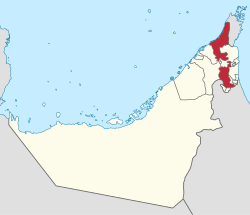Ras al Khaima
|
Ras al-Khaimah إمارة رأس الخيمة Ra's al-Khaymah |
|||
|---|---|---|---|
| Emirate | |||
| Emirate of Ras al-Khaimah | |||
 |
|||
|
|||
 Location of Ras al-Khaimah in the UAE |
|||
| Coordinates: 25°47′N 55°57′E / 25.783°N 55.950°ECoordinates: 25°47′N 55°57′E / 25.783°N 55.950°E | |||
| Country |
|
||
| Emirate |
|
||
| Government | |||
| • Type | Absolute monarchy | ||
| • Ruler | Saud bin Saqr al Qasimi | ||
| • Crown Prince | Mohammed bin Saud al Qasimi | ||
| Area | |||
| • Total | 1,684 km2 (650 sq mi) | ||
| Population (2008) | |||
| • Total | 263,217 | ||
Ras al-Khaimah (alternatively Ra'sal-Khaymah or Ras el-Kheima; Arabic: رأس الخيمة; IPA: [raʔs alˈxajma]) is one of the seven emirates that make up the United Arab Emirates (UAE). The current statehood is the result of the 1909 appanage from Sharjah. Its name could be taken to mean "headland of the small huts", which can be attributed to the indigenous buildings that existed along the coast. The emirate is in the northern part of the UAE, bordering Oman's exclave of Musandam. It covers an area of 1,684 square km. The capital city and home of most residents is also called Ras Al Khaimah. The emirate had a population of 210,063 at the 2005 Census, of which 41.82 percent or 87,848 were Emirati citizens. Latest estimates put the total population at between 250,000 and 300,000. Locals accounted for 97,529 in the population estimate for 2010.
The city has two main sections, Old Ras Al Khaimah and Nakheel, on either side of a creek. It is served by the Ras Al Khaimah International Airport. It consists of a northern part (where the city of Ras al-Khaimah is situated), and a large inland exclave in the south (near Hatta), and a few small islands in the Persian Gulf. Ras al-Khaimah has the most fertile soil in the country, due to a larger share in rainfall and underground water streams from Omani mountains.
Ras al-Khaimah has been the site of human habitation for several millennia and there are many historical and archaeological sites throughout the emirate - local sources cite 1,000 - dating from different time periods, including remnants of the Umm an-Nar Culture (3rd millennium BC). Ancient graves were found in the Emirate in October 2012.
...
Wikipedia


